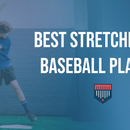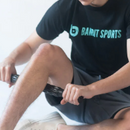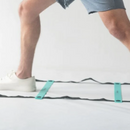
Best Stretching Exercises For Baseball Players
Baseball players need to stay limber and flexible to perform at their best. Without proper stretching, they may be more prone to injury and won't be able to move as freely on the field. That's why it's essential for baseball players of all levels to incorporate stretching exercises into their warm-up routine. By keeping their muscles loose, they'll be able to hit, throw, and run with greater ease and accuracy. So what are the best stretching exercises for baseball players?
Maintaining flexibility is a key factor in any athlete's performance and overall health, but it can be especially important for baseball players due to the wide range of motions required of them while playing. From pitching and catching to batting and running bases, flexibility is essential for executing moves quickly and smoothly without risking injury. That's why it's important that baseball players take time before each game or practice session to warm up their muscles with stretches tailored specifically towards their sport.
There are many different stretches that are beneficial for baseball players, but not all of them will provide the same level of benefit or cover all areas that need attention. To ensure they're getting the most out of their stretching routine, athletes should focus on dynamic stretches that target major muscle groups used in playing baseball such as legs, back, arms, shoulders, chest, hips, and core muscles.
These are some of the best exercises so you can get your body ready for a great baseball game!
Definition Of Stretching
Stretching is an important part of any physical activity. It helps to increase flexibility and range of motion, as well as improving overall performance. Stretching can also help reduce muscle tension and soreness, which is especially beneficial for athletes. Baseball players should incorporate stretching into their daily routine in order to improve their performance on the field.
Static stretching is the most common form of stretching used by baseball players. This type of stretching involves holding a position for an extended period of time, usually 15-30 seconds. Dynamic stretching is another option which involves controlled movement through a full range of motion and can be more beneficial than static stretches when it comes to preparing the body for physical activity. When done correctly, both types of stretching can help to improve flexibility and range of motion, as well as reduce muscle tension and soreness.
Benefits For Baseball Players
Stretching exercises for baseball players offer numerous benefits. First, stretching helps to improve flexibility and range of motion, which can reduce the risk of injury during practice or a game. In addition, it can also help to increase power, performance and speed. Stretching also reduces muscle tension, which can help prevent soreness after playing. Lastly, stretching can help to improve posture and coordination while running and throwing.
Regularly incorporating stretching into a baseball player’s routine will help them stay healthy and perform at their best on the field. They’ll be able to move more freely and with greater accuracy than before. This increased mobility will result in better performance and fewer injuries over time.
Pre-Game Warm Up Exercises

Now that the benefits of playing baseball have been discussed, it's time to focus on pre-game warm up exercises. Before any game, it's important for a baseball player to properly stretch their muscles in order to reduce the risk of injury and maximize performance.
Stretching exercises should target all major muscle groups, including the arms, chest, shoulders, back, legs and core muscles. For example, arm circles are a great way to warm up the shoulders and arms before throwing a ball. Another exercise is trunk rotations which help loosen up the spine and lower back muscles. Leg swings are also beneficial for loosening up tight muscles in the legs and hips for running. Finally, dynamic stretching can be used as a form of active recovery between innings or before batting practice. Dynamic stretching involves slower movements that mimic those used during games such as sidesteps or jogging in place.
By focusing on these pre-game stretching exercises, baseball players can prepare their bodies for an intense game while reducing the risk of injuries or muscle strains. With proper warming up and cooling down routines before and after each game, players can ensure they are performing at their best with minimal risk of injury.
Post-Game Cool Down Exercises
After a long game, baseball players should cool down their bodies. This helps reduce soreness and prevent injury. To do this, a few simple stretching exercises can help. Begin with light jogging for five to ten minutes. This will bring the heart rate back to normal and loosen up tight muscles.
Next, perform a series of static stretches that target the major muscle groups used in the game, such as the hamstrings, quadriceps, calves, chest, shoulders and back. Hold each stretch for about 30 seconds before switching to the next one.
Finally, end with foam rolling or massage therapy to further relax the body's muscles and improve blood circulation throughout the body. Doing these cool down exercises after every game can greatly benefit baseball players by helping them recover quickly and remain injury-free so they can continue playing at their best.
Dynamic Stretches
Moving on from post-game cool down exercises, dynamic stretches are also an important part of any baseball player's workout routine. Dynamic stretches are active stretches that involve movement while stretching the muscle. They help improve flexibility, coordination, and balance while preparing the body for more intense movements.
Dynamic stretches can be done before or after a game or practice session to increase range of motion and reduce injury risk. Examples of dynamic stretching exercises include leg swings, arm circles, and high knees. Leg swings involve swinging the legs back and forth in both directions while maintaining control over the movement. Arm circles involve moving your arms in small circles to stretch out the shoulder muscles. High knees is a running drill designed to engage the core and hip flexors by bringing your knees up as high as possible when running in place.
Dynamic stretching can help baseball players prepare for their games and practices by increasing mobility, stability, and overall performance on the field. Taking time to warm up properly with dynamic stretching will not only help prevent injury but also enhance performance during a game or practice session.
Static Stretches

Static stretches are an important part of a baseball player's warm-up routine. These stretches involve stretching the muscle to its end range of motion and holding it there for a duration of time. Examples of static stretches include calf raises, trunk rotations, and shoulder circles. Static stretching helps to increase flexibility and reduce the risk of injury by increasing blood flow to the muscles, tendons, and ligaments.
When performing static stretches, it is important to move slowly and pay attention to any sensations in the body. If something doesn't feel right or causes pain, stop immediately and try again with a new stretch or modified version of the same one. Stretching should not cause pain but rather a comfortable sensation in the muscle that allows for greater range of motion.
Upper Body Exercises
Upper body stretches are an important part of a baseball player's routine. Stretching the upper body helps to increase range of motion and flexibility, which can improve performance in the field and at bat. It also helps to reduce risk of injury by keeping muscles, ligaments, and tendons loose and relaxed.
Some great upper body stretches for baseball players include shoulder rolls, arm circles, chest openers, triceps stretch, and neck rotations. Shoulder rolls involve rolling the shoulders backward in a circular motion for 15 seconds before alternating direction for another 15 seconds. Arm circles involve swinging both arms forward in a circular motion for 10 seconds before switching directions for another 10 seconds. Chest openers require standing with feet apart and arms outstretched wide behind you before bringing your hands together behind your back as far as comfortable and holding this position for 10-15 seconds. The triceps stretch requires putting one arm across your chest while using the other hand to press down on the elbow of that arm for 15 seconds before switching sides. Neck rotations involve turning your head from side to side slowly for 10-15 seconds per side.
These simple stretches can help baseball players stay flexible and reduce their risk of injury during practices or games. Additionally, they can help keep muscles loose throughout the season so that they remain strong enough to perform well on game day.
Lower Body Exercises
Moving on, let's look at lower body exercises specifically beneficial for baseball players. Stretching the muscles in the lower body can help improve a player's athleticism, power, and range of motion when throwing and fielding. Furthermore, stretching helps to reduce the potential for injury.
The most important lower body stretches for baseball players include hip flexor stretches, hamstring stretches, calf stretches, and gluteal stretches. Hip flexor stretches involve standing with one leg extended behind you and holding the foot of that leg with your hand while keeping your torso upright. Hamstring stretches require sitting on the ground with one leg straight out in front of you and leaning forward from your hips until you feel a stretch in the back of your thigh. Calf stretches involve standing straight up with one foot in front of the other and pushing down with your back foot until you feel a stretch in the calf muscle of that leg. Gluteal stretches are done by lying flat on your back and crossing one ankle over your knee before pulling it towards your chest until you feel a stretch in your buttocks area.
These exercises can be done daily as part of a pre-game warmup routine to ensure optimal performance and reduce risk of injury throughout a game or practice session.
Core Exercises
Core exercises are essential for baseball players to increase their performance. Planks, push-ups, and sit-ups are all great core exercises that can help build strength in the abdominals and back muscles. Planks target the entire core and work to simultaneously strengthen the arms, shoulders, chest, and legs. Push-ups are best for upper body strength while sit-ups focus on developing abdominal muscles. All of these exercises should be done slowly with proper form in order to get the most out of them. Additionally, using a stability ball can add an extra challenge to these core exercises by forcing players to engage more muscles than they would with just body weight alone.
It's important for baseball players to add variety into their stretching routine in order to keep their bodies strong and healthy. Working on the core is one way of doing this as it will help improve balance and agility while also helping players avoid injury both during practice and in games. It’s essential that players take time each day to focus on strengthening their core so that they can perform at their best when stepping onto the field.
Abdominal And Back Strengthening Exercises
Moving on from core exercises, abdominal and back strengthening exercises are essential for baseball players. Strengthening the muscles in these areas helps to keep the spine healthy and prevent injury. This is important for any athlete as a strong core makes it easier to move quickly and efficiently on the field.
One of the best ways to strengthen the abdominals and back muscles is with planks. Planks require you to maintain a plank position for at least 30 seconds; this engages both your abdominal and lower back muscles for maximum benefit. Other great exercises include bird-dogs, which involve alternating between extending your arm forward and one leg backward, as well as reverse crunches, which work the lower abdominals by lifting your legs up off the ground while lying on your back.
By incorporating these exercises into your routine, you can help ensure that you are getting strong enough to perform well during games. With regular practice, you can improve your posture, agility, balance and stability, all of which will help you succeed on the baseball diamond.
Shoulder And Arm Mobility Exercises

Shoulder and arm mobility exercises are essential for baseball players to improve flexibility, reduce injury risk, and maximize performance. Shoulder circles are a great way to warm up the shoulder joints and increase range of motion. Stand with your feet shoulder-width apart and hold your arms out in front of you at shoulder level. Begin by slowly making small circles with your arms in one direction, then reverse the direction. Increase the size of each circle as you go along until you feel a stretch in your shoulders. You can also do this exercise while lying on your back on a flat surface.
For arm mobility, try triceps stretches to target the muscles in the back of the upper arm. Start by bringing one arm across your body and place it on the opposite shoulder blade, then use your other hand to pull it lightly toward you until you feel a stretch through the triceps area. Hold for 30 seconds before switching sides. Do three sets of 10 reps per side for maximum results. By incorporating these exercises into your warm-up routine, you'll be able to increase flexibility and reduce injury risk while improving overall performance on the field.
Plyometric Training
Now that we have discussed stretching exercises for baseball players to improve shoulder and arm mobility, let's discuss plyometric training. Plyometric training involves rapid movements that involve jumping, bounding, and hopping. These exercises help to engage the muscles used in explosive movements like pitching and throwing. Plyometrics can also help to increase speed, power, and overall athleticism.
Plyometric exercises should be done with caution to avoid injury. It is important to warm up adequately before beginning any exercise routine, as well as ensure proper form throughout the workout. Plyometrics should also be performed on a soft surface such as grass or a mat so as not to overload the joints. With these precautions in mind, plyometrics can be an excellent addition to a baseball player's exercise regimen.
Injury Prevention Strategies
Injury prevention is an essential part of any baseball player’s performance and long-term success. Stretching can help to improve flexibility and reduce the risk of injury during intense physical activity. Static stretching exercises, such as calf stretches and shoulder rolls, should be done several times a week to maintain joint range of motion. Dynamic stretching exercises, like arm circles and leg swings, are best done before games or practice in order to prepare the body for strenuous activity.
Additionally, baseball players should stay hydrated during games and practices by drinking plenty of fluids. Wearing proper safety equipment is also important in order to protect against injury. Helmets should be worn while batting and catching, and protective cups should be worn while pitching or playing the infield. With proper stretching exercises, hydration, and safety equipment, baseball players can reduce their risk of injury on the field.
Nutrition Tips For Baseball Players
Nutrition plays a critical role in the performance of any athlete, and baseball players are no exception. To ensure optimal physical performance, it is important for baseball players to follow a balanced diet that includes plenty of carbohydrates, proteins, and healthy fats. Eating foods that are high in fiber can also help fuel muscles during games and practice sessions. Additionally, hydration is key for any athlete's success; drinking plenty of water will help keep energy levels up throughout the game.
It may be beneficial for baseball players to keep track of their calorie intake and adjust it depending on their needs. For instance, athletes who need to gain muscle mass may benefit from an increased intake of protein-rich foods such as lean meats or tofu. On the other hand, those looking to maintain their current weight may require fewer calories each day. As always, consulting with a nutritionist or dietician can help players find the best plan for their individual needs.
Recovery Techniques
After a hard practice or game, baseball players should focus on recovery techniques to help their body heal and prepare for the next day. It's important to give your muscles time to rest and rebuild after exercise. One way to do this is with a cool-down routine. This can include light jogging or walking, as well as dynamic stretching and foam rolling exercises. Both of these activities will help reduce muscle stiffness and soreness.
Additionally, proper nutrition plays an important role in recovery. Eating a balanced meal that includes protein and carbohydrates within two hours of working out helps replenish energy stores, restore fluid levels, and repair damaged tissue. To further aid in recovery, baseball players should also consider taking an ice bath or cryotherapy session after rigorous workouts or games. Ice baths can reduce inflammation while cryotherapy sessions can help speed up the healing process by reducing pain and swelling in the muscles. Taking these steps will help keep baseball players in top shape throughout the season!
Stretching Exercises are Essential for Success in Baseball
Stretching is an essential part of any baseball player's routine. It helps to improve performance, reduce the risk of injury, and enhance recovery. When done correctly, it can provide a wide range of benefits for baseball players. Before games and practices, it’s important to warm up with dynamic stretches and plyometric training. After playing, cool down with static stretches and consider using recovery techniques such as foam rolling or massage. Finally, pay attention to nutrition to help fuel your body for peak performance.
By following these tips and incorporating stretching into your routine, you'll be able to maximize your potential as a baseball player. You'll also be better prepared for the demands of the game and have fewer worries about injuries or fatigue. With regular stretching, you can stay healthy and maintain peak performance throughout the season.
So take some time each day to stretch out your muscles and make sure you're doing everything you can to get the most out of your body on the diamond. With dedication and commitment, you'll be well on your way to becoming one of the best baseball players around!
If you're a baseball player, a subscription for Plate Crate could be just what you are missing from your life.
Members receive A Different Themed Crate Each Month. Every Plate Crate Contains 6-8 Unique Items, Including Gear, Snacks, Training Aids, Accessories, And Apparel





